The Holocaust
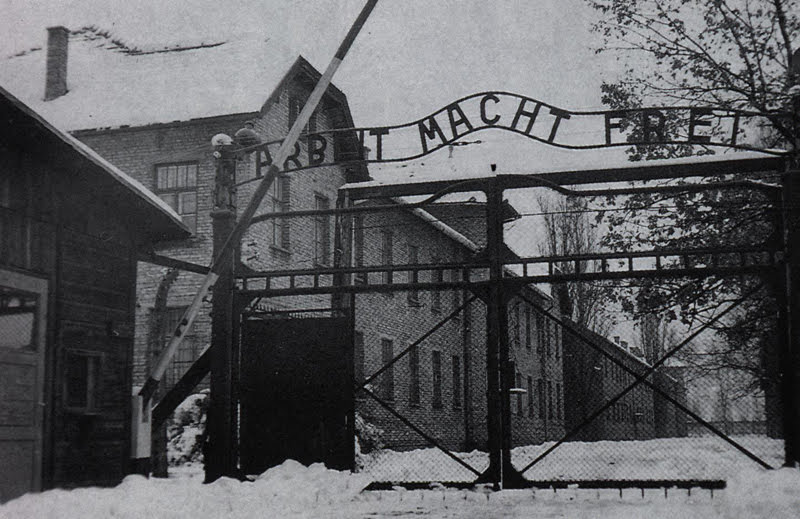
SOME PERSPECTIVE:
Here's who bore the real cost of WWII, in terms of military lives lost: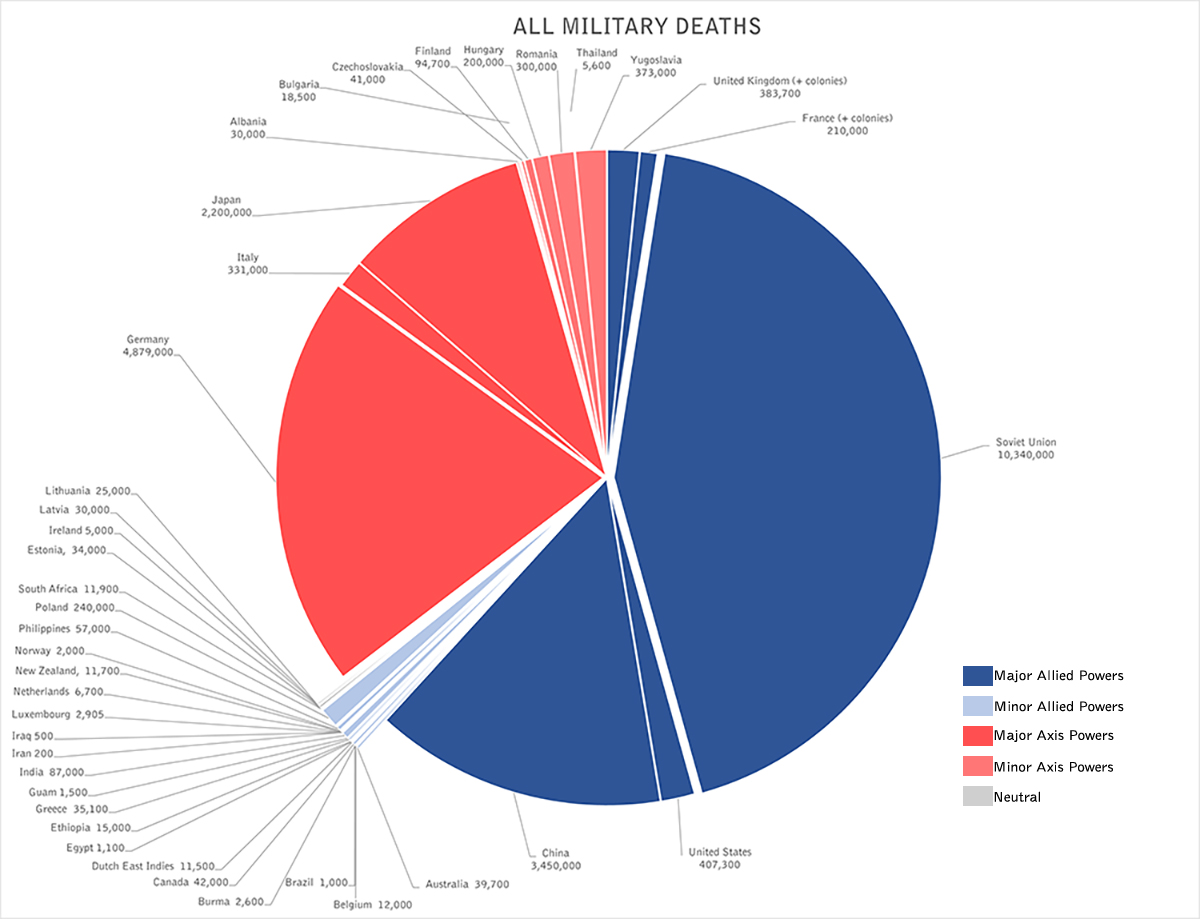
And, even worse, here are the civilians who died, either through military action / crimes against humanity or through war-related famine or disease.
The deaths in the USSR and China are literally at another order of magnitude than those suffered almost anywhere else.
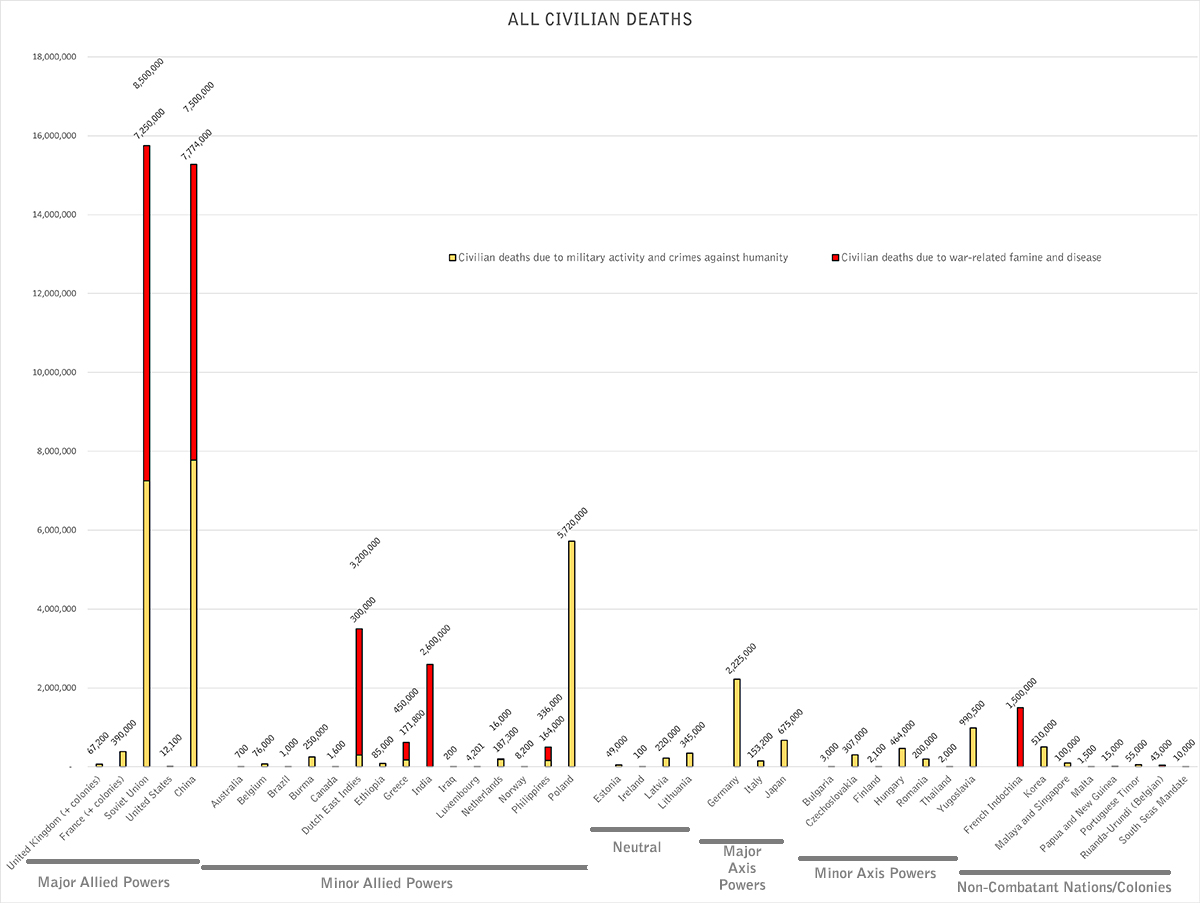
You can gain some appreciation for the scale of this loss when you consider that a quarter of a million civilians were killed in Burma, and that's barely noticeable on this graph.
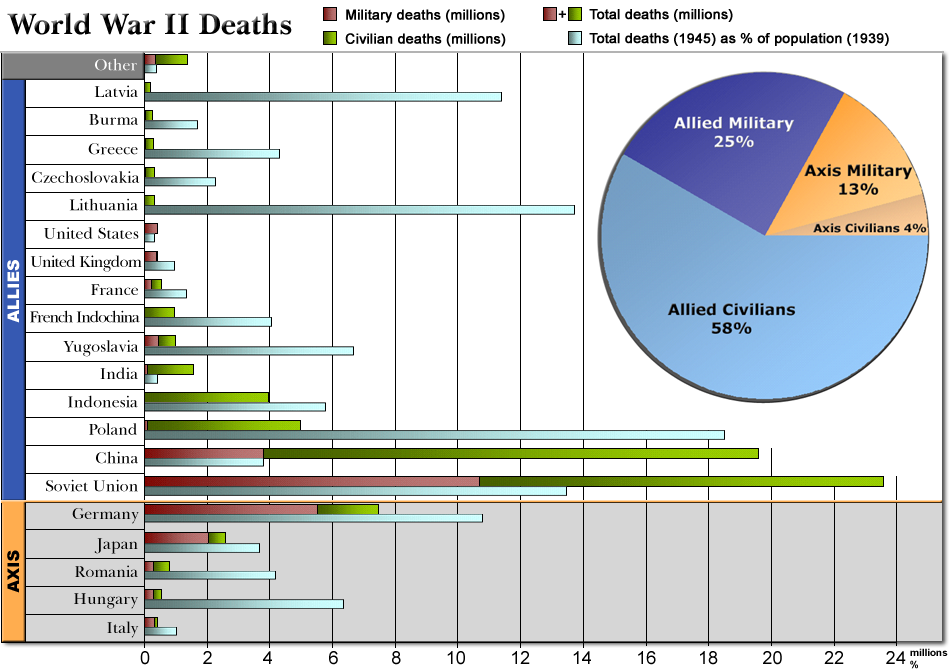
A larger perspective on WWII deaths
| Victims | low estimate | high estimate |
| Jews | 5,900,000 | 5,900,000 |
| Poles | 2,700,000 | 3,200,000 |
| Ukranian Slavs | 2,900,000 | 3,100,000 |
| Soviet POWs | 2,000,000 | 3,000,000 |
| Belarusian Slavs | 1,250,000 | 1,500,000 |
| Serbs | 300,000 | 500,000 |
| Disabled | 250,000 | 270,000 |
| Romani | 220,000 | 1,500,000 |
| Freemasons | 80,000 | 200,000 |
| Slovenes | 20,000 | 25,000 |
| Homosexuals | 5,000 | 15,000 |
| Spanish Republicans | 5,000 | 7,000 |
| Jehovah's Witnesses | 2,500 | 5,000 |
| TOTAL | 15,632,500 | 19,222,000 |
BEFORE THE CAMPS

German hyperinflation in the 1920s caused people to burn money.
The paper money was cheaper than wood or coal, and families used it to fuel their fires during the crisis.
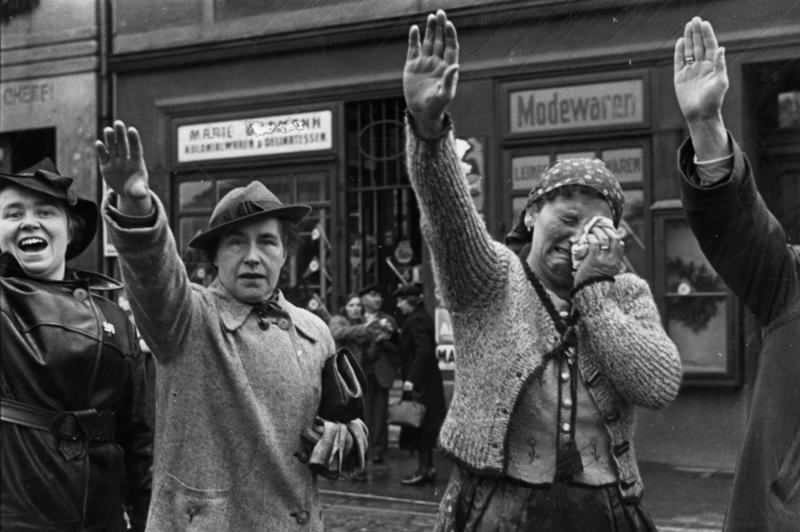
The reactions of Czechoslovakian citizens in Sudeten
greeting German soldiers as they march past them in 1938.

A woman on the verge of starving to death in the Warsaw Ghetto, in 1941.
This picture was taken by Heinz Joest, a German Wehrmacht Sergeant, who illegally took this and other pictures that would eventually be smuggled out of the Reich to show the horrors happening inside it.
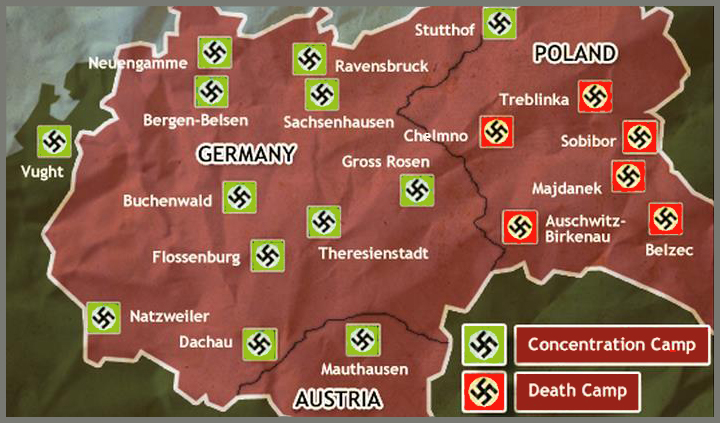
A map of the major concentration camps and death camps.
IN THE CAMPS
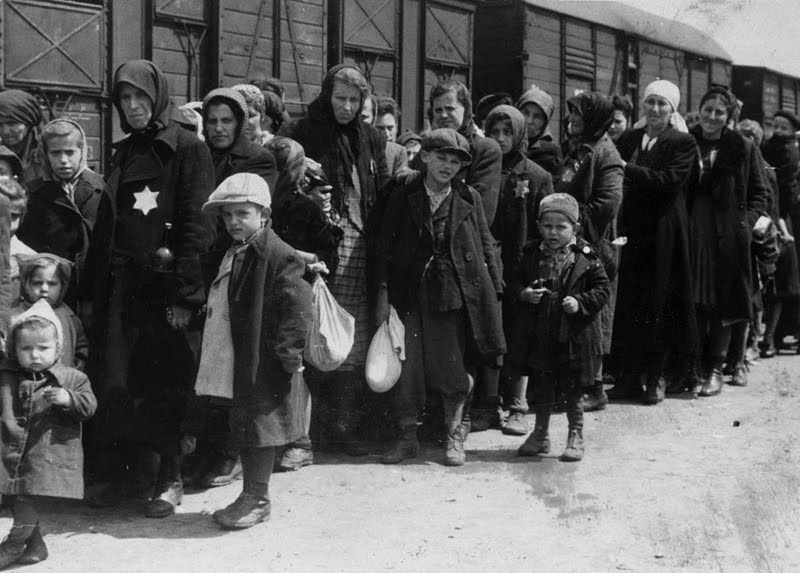
A train unloading at a concentration camp.
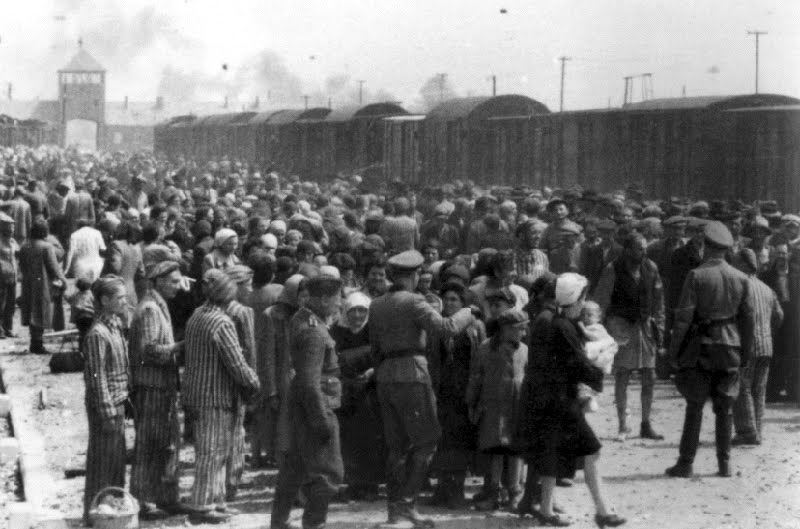
A typical selection process.
An SS officer directs the woman with her infant child to join those being sent to the crematorium.
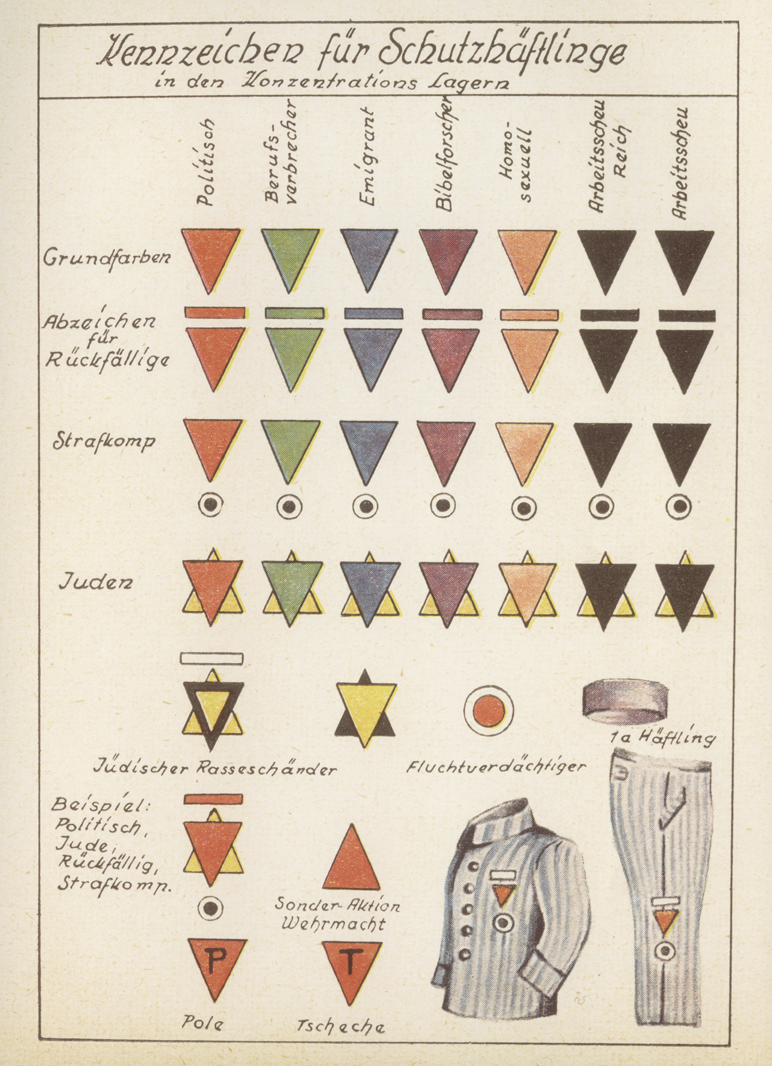
The badges sewn onto prisoners' uniforms.
These badges enabled SS guards to identify a prisoner's grounds for incarceration, and differed slightly from camp to camp.
| Yellow star or triangle: | Jewish prisoner |
| Green triangle: | Criminals |
| Red triangle: | Political prisoners |
| Black triangles: | "Asocials" — non-conformists, vagrants, the mentally ill |
| Brown triangles: | Roma & Sinti |
| Pink triangles: | Gay men |
| Purple triangles: | Jehovah’s Witnesses |
| Blue triangles: | Foreign prisoners |
If prisoners were not German, they also had the first initial of the place they came from on their badges. They also had differing colors if they fell into a number of categories (e.g., a Jewish political prisoner would have a yellow and red star).
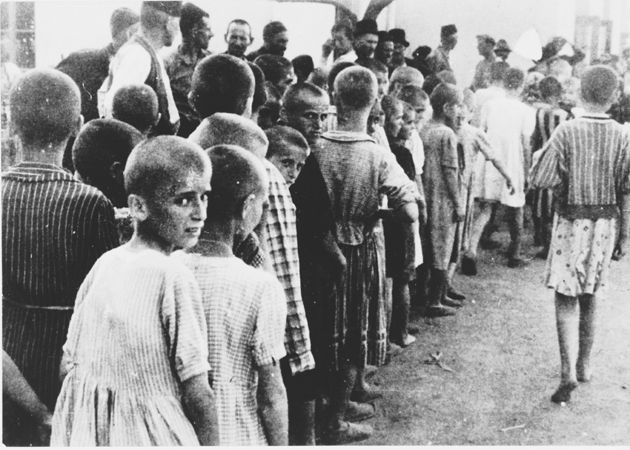
After having their heads shaved, children line up to be given work assignments
(Jasenovac camp, 1944).

Prisoners at forced labor in the Mauthausen camp.
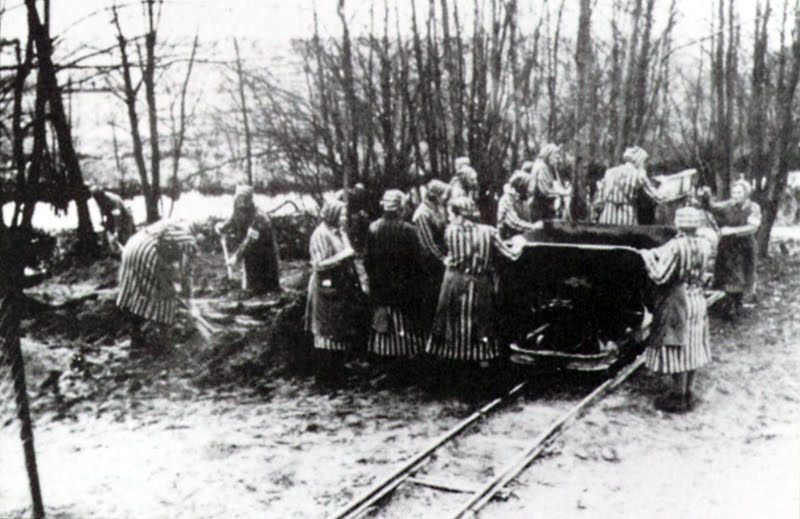
Prisoners at forced labor in the Ravensbruck camp.

Crematorium ovens with bones at Bergen-Belsen.
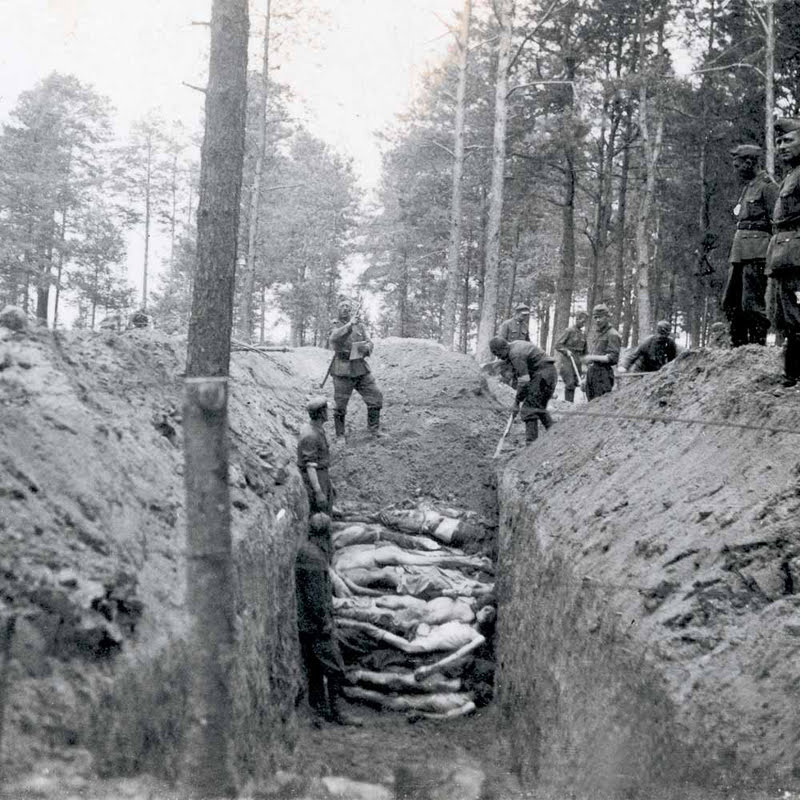
A mass grave at Belzac.
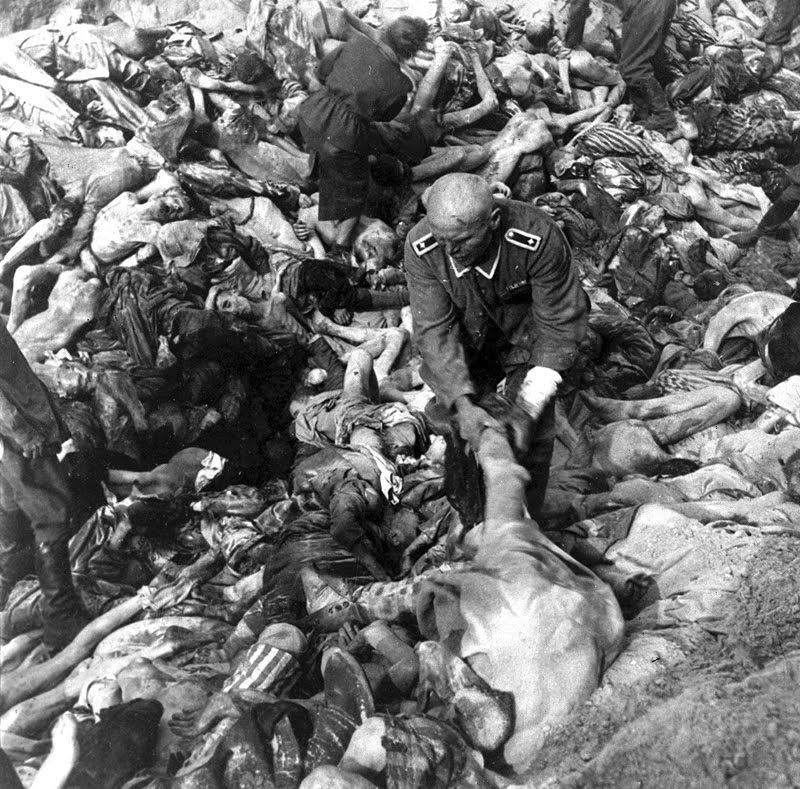
An SS guard hauls another body into a mass grave in Belsen (April 1945).
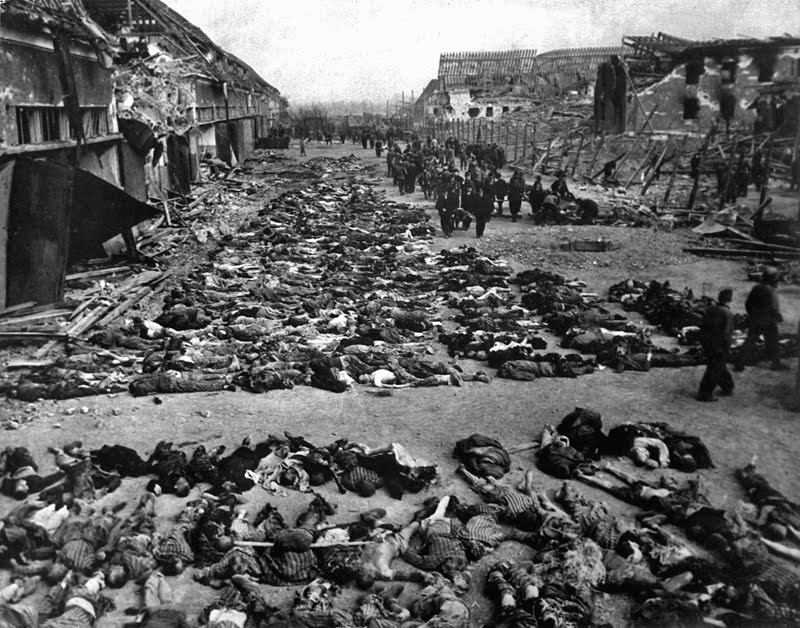
Rows of bodies at the Nordhausen camp.
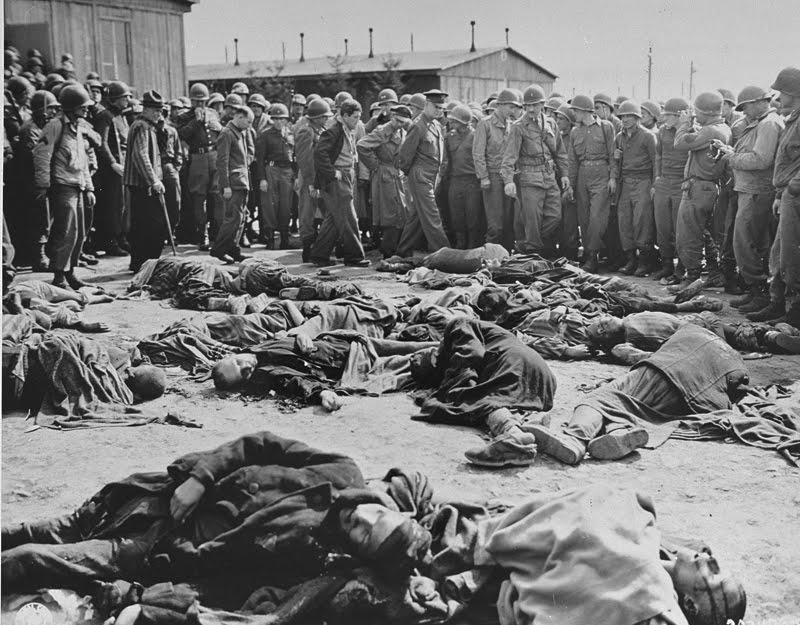
General Eisenhower at the liberation of Buchenwald.
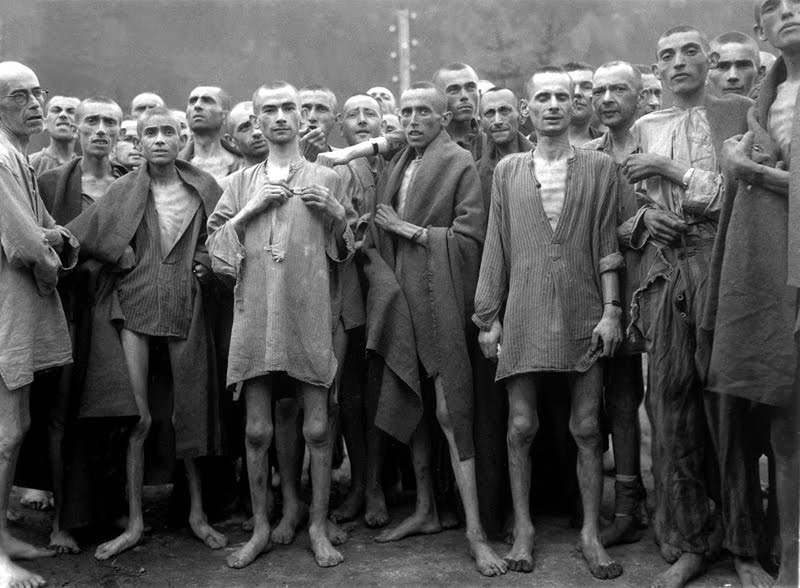
Camp survivors at the liberation of Ebensee.
TODAY
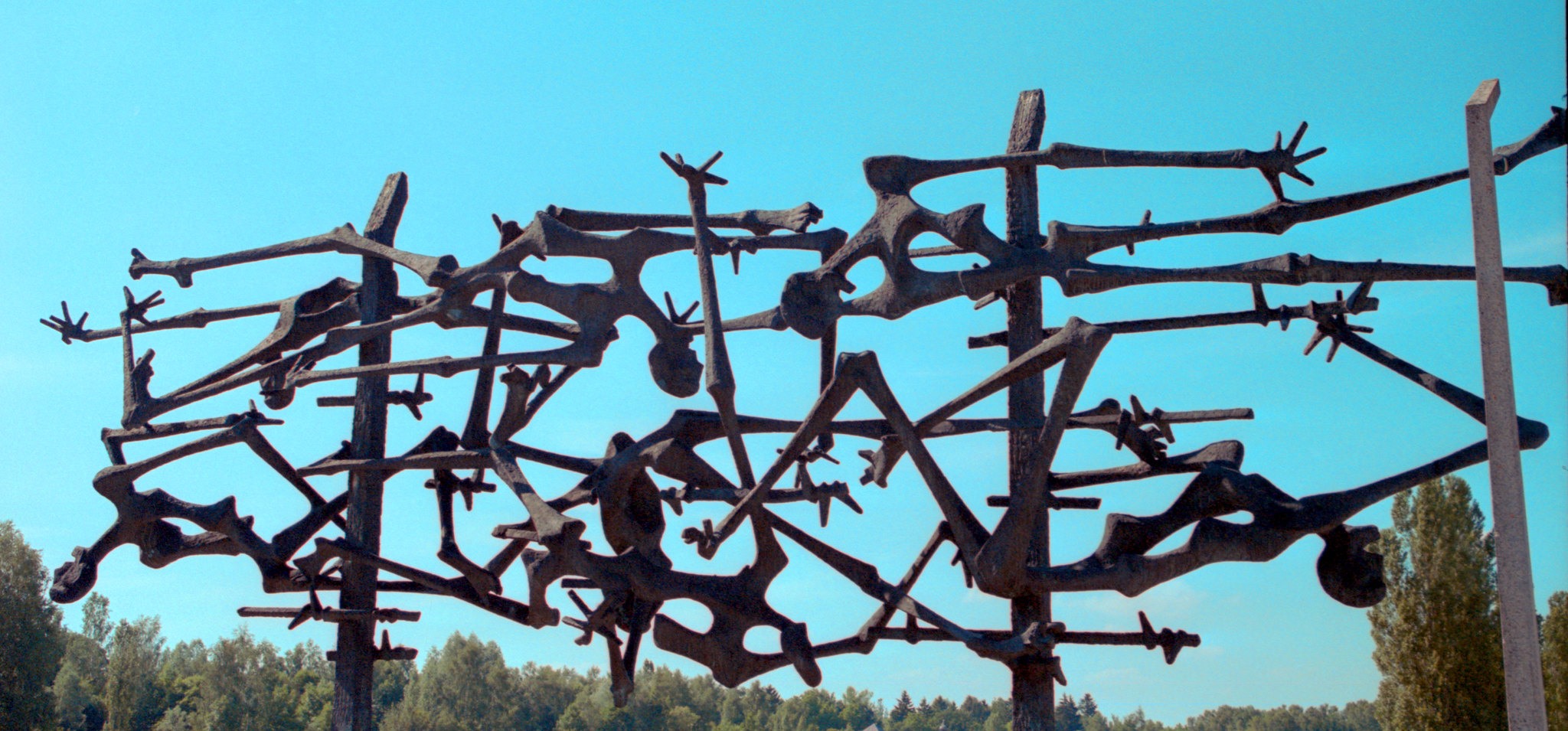
This sculpture is part of the International Monument at the Dachau Memorial Site.
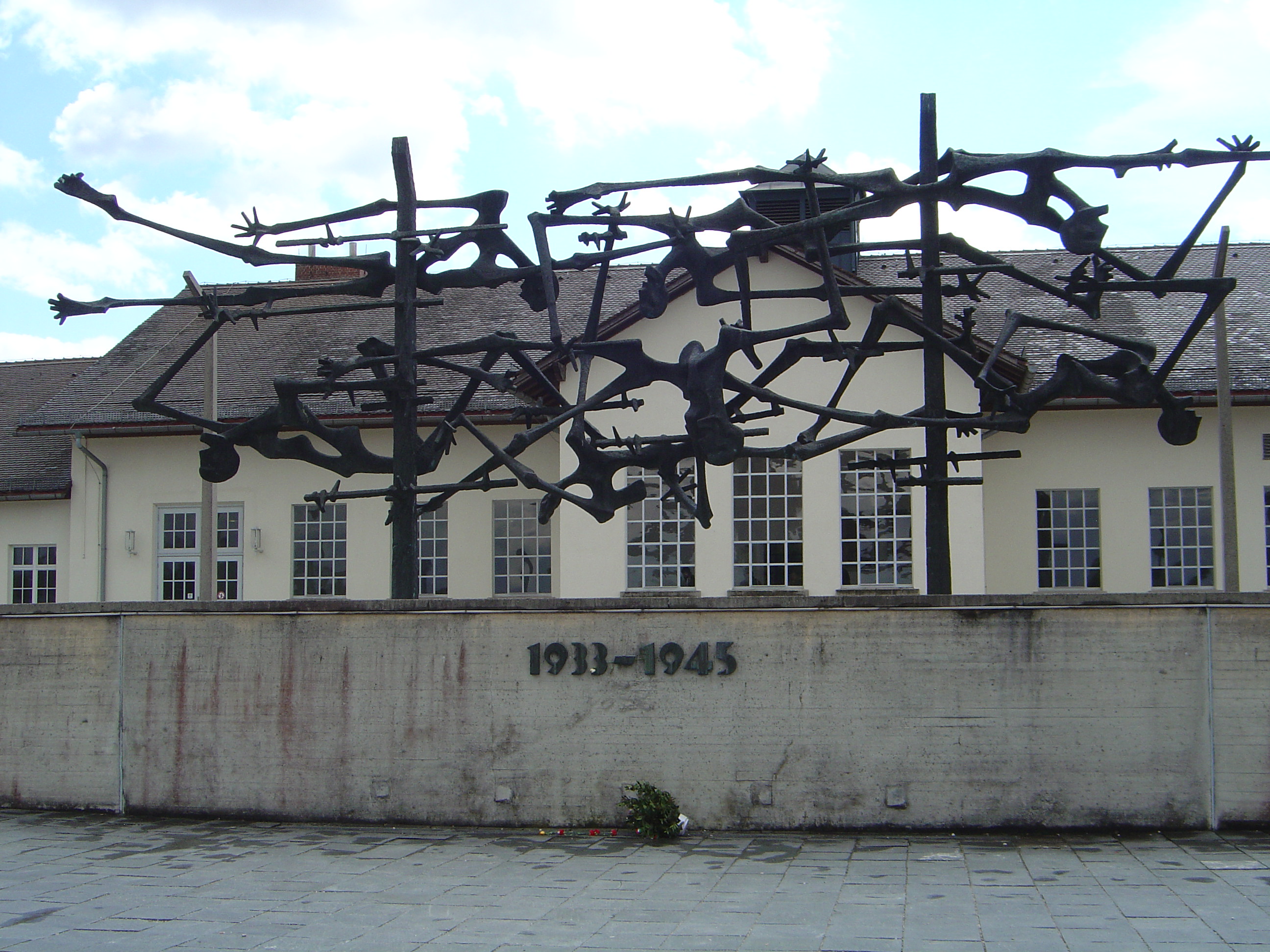
The bodies are depicted as trapped in barbed wire. Many prisoners tried to escape by climbing over the barbed wire, and were shot on the wire. Their bodies were sometimes left in the wire as a warning.

The Unknown Prisoner
A memorial statue erected by the survivors of Dachau.
The inscription reads: "To remember the dead and to warn the living."

The prisoner is sculpted with a coat and shoes, because prisoners didn't have them.
He looks up, because prisoners were forced to always look down.
His hands are in his pockets, because prisoners were punished if they did this.
Shalechet — Fallen Leaves, in the Berlin Jewish Museum
Israeli artist Menashe Kadishman created the installation "Shalechet – Fallen Leaves," for the museum. It is a collection of 10,000 faces punched out of steel and distributed on the ground of the Memory Void, the only empty or "voided" space in the museum that can be entered. Kadishman dedicated his artwork not only to Jews killed during the Shoah, but to all victims of violence and war. Visitors are invited to walk on the faces and listen to the sounds created by the metal sheets, as they clang and rattle against one another. Kadishman says that the sound of the steel faces as they ring against one another is the voice of those voiceless victims of the Holocaust.
The Shoe Room, in the US Holocaust Museum
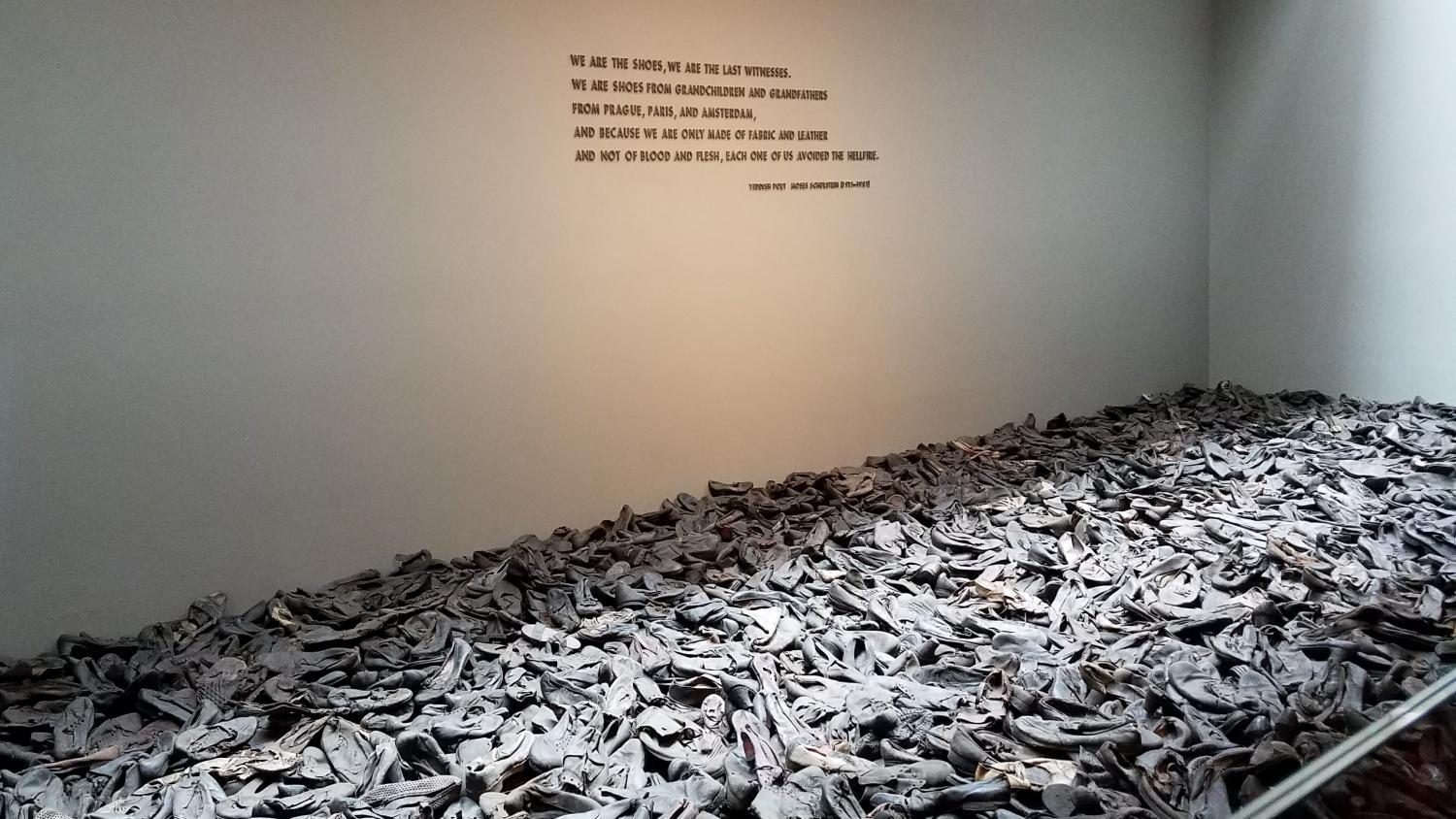
Shoes. Old shoes. New shoes. Worn shoes. Badly repaired shoes. Some withered with use. Some scuffed from hard work. Black leather shoes. Brown cloth shoes. Men's shoes. Women's shoes. Wide shoes. Narrow shoes. Children's shoes. Baby shoes. All of them from a sorting of eventual victims at a concentration camp.
We are the shoes, we are the last witnesses.
We are shoes from grandchildren and grandfathers
From Prague, Paris and Amsterdam,
And because we are only made of fabric and leather
And not of blood and flesh,
Each one of us avoided the hellfire.
― Moshe Szulsztein
THE TABLES HAVE TURNED
"We are fighting human animals."
- Heinrich Himmler, ReichsFührer of the SS
- Joseph Goebbels, Reichsminister for Propaganda
- Hermann Göring, Commander-in-Chief of the Luftwaffe
- Yoav Gallant, Defense Minister of Israel
Rather than walk back this statement, Israeli officials (and at least one US Representative) have defended it and even doubled down on it:
"Animal humans will be treated accordingly." — Ghassan Alian, Major General of the Israeli Army 2
"The monsters in Gaza should find a solution by themselves." — Amichai Eliyahu, Israeli Heritage Minister 3
The members of Hamas are "bloodthirsty animals, " and Israel will now “move from containment to eradication.” — Ron Prosor, Israel’s Ambassador to Germany (and former permanent delegate to the UN) 4
“I would encourage the other side to not so lightly throw around the idea of ‘innocent Palestinian civilians,’ as is frequently said, I don’t think we would so lightly throw around the term ‘innocent Nazi civilians’ during World War II.”
AND
“I would challenge anybody in here to point to me which Palestinian is Hamas and which one is an innocent civilian.” — US Representative Brian Mast (R, MI)5
"Animalization is a tool of choice in the genocidal arsenal, because it is by denying the humanity of the members of a group that we justify its eradication."6
"Raz Segal [Associate Professor of Holocaust and Genocide Studies at Stockton University and an endowed professor in the study of modern genocide], an Israeli expert in modern genocide, calls Israel’s assault on Gaza a textbook case of 'intent to commit genocide' and its rationalization of its violence a 'shameful use' of the lessons of the Holocaust. Israeli state exceptionalism and comparisons of its Palestinians victims to 'Nazis' are used to 'justify, rationalize, deny, distort, disavow mass violence against Palestinians.'” 7
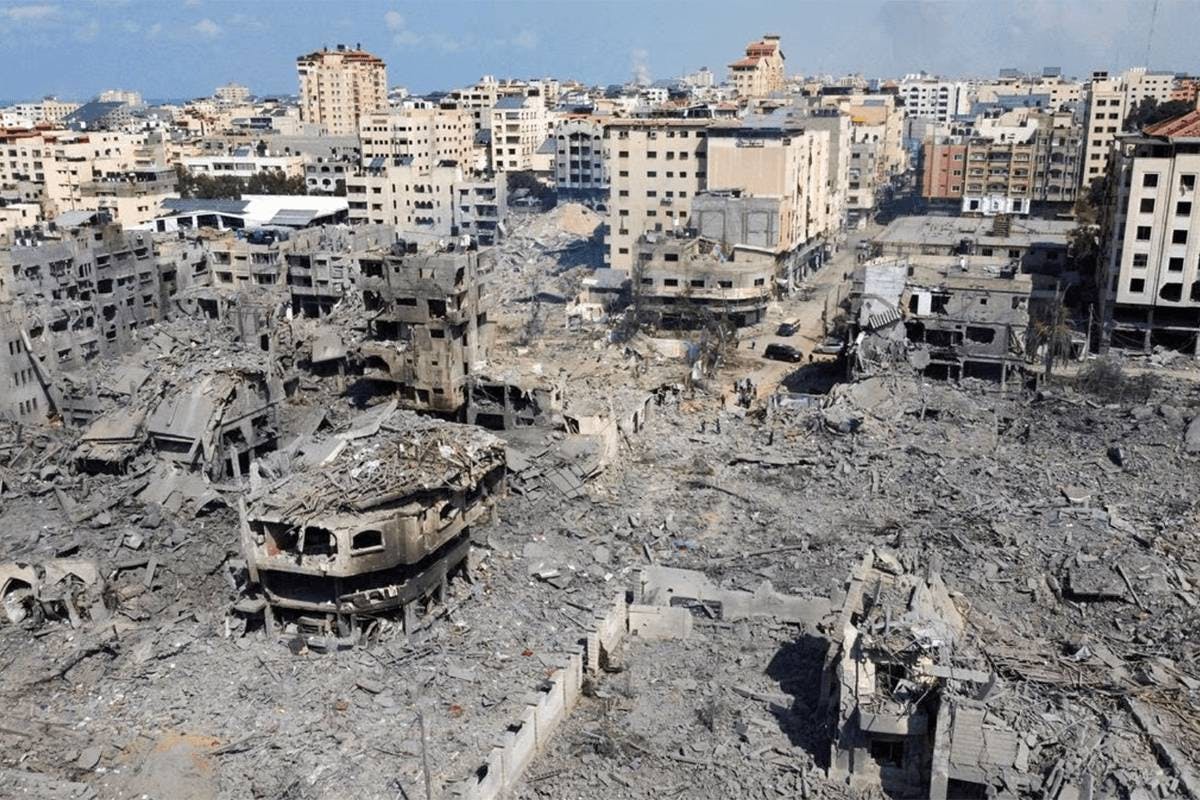
Israeli bombing of Gaza, day 1

Israeli bombing of Gaza, day 2
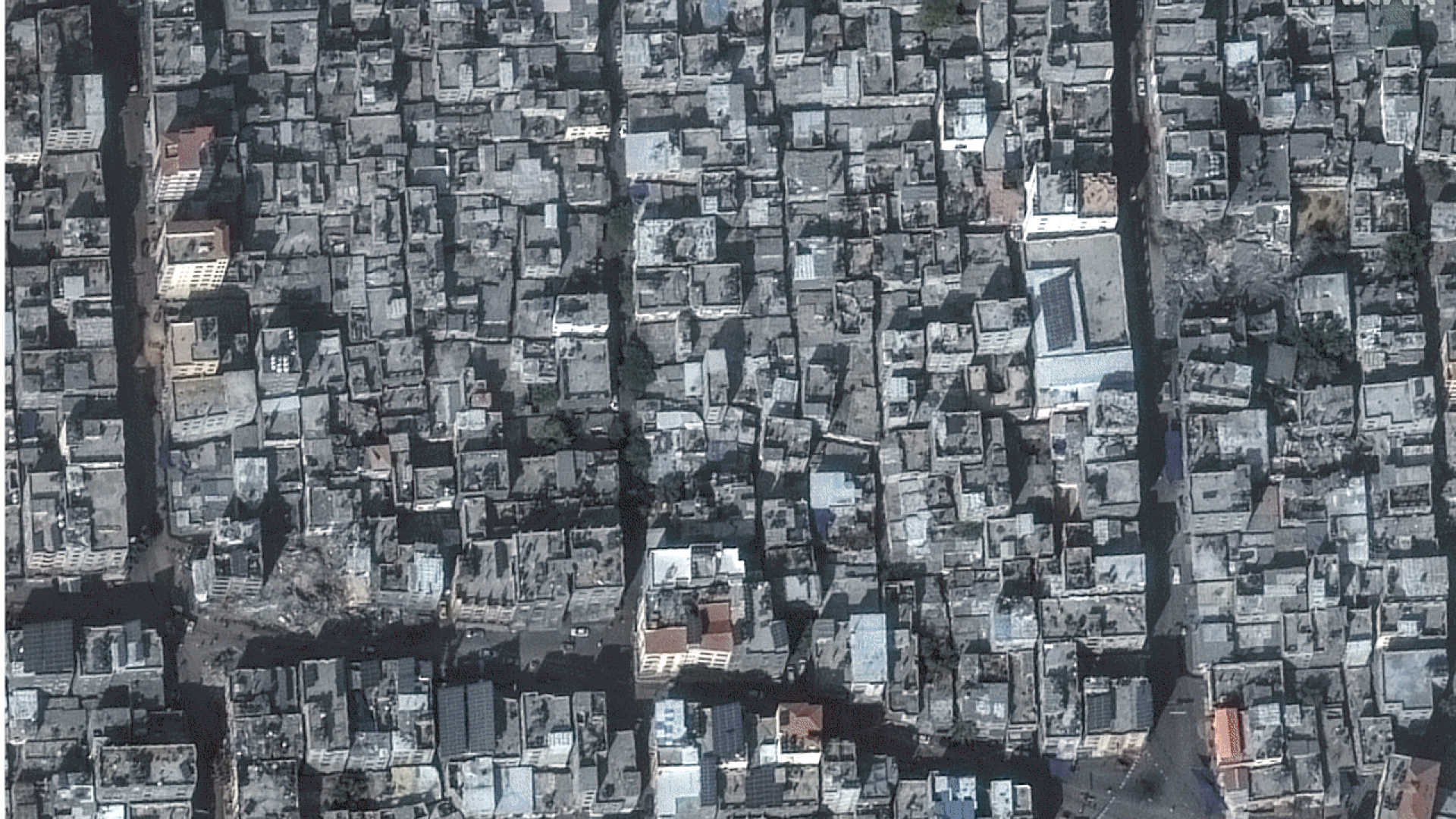
The Jabaliya Refugee Camp, on October 31, 2023, and on November 1, 2023.
None of this, the attacks, the counter-attacks, the displacements, the siege, the denial of humanitarian aid, the cutoffs of electricity, water, and food, none of this occurs in a vacuum.
So when do we start addressing the context? When do we start keeping score? How about in 1948 with the creation of the State of Israel and the forced displacement of millions of Palestinians? Or maybe we go back to before the Common Era, and justify Israeli incursions into Palestinian land because some book says that they should have that land? Or do we take into account the thousands of years of Western anti-Semitism? What about the Holocaust? Does the world not owe those victims something?
No matter where we start, here are the contemporary facts:
Initial Attack: October 7, 2023 |
Israeli Response: October 8, 2023 - ongoing |
| Hamas and other armed Palestinian groups begin Operation Al-Aqsa Flood. They launch at least 3,000 rockets into Israel, breach the Gaza-Israel barrier, target civilians for killing in neighboring Israeli communities, attack military bases, and take hostages back to Gaza. | The Israeli Defense Force launches Operation Swords of Iron in Gaza. As of November 6, 2023, they have dropped over 32,000 bombs on Gaza. |
Operation Al-Aqsa Flood |
Operation Swords of Iron |
|
Israeli civilians killed: 1,033 Israeli military killed: 299 Israeli police killed: 58 Israeli civilians / soldiers taken hostage: 200 + Israeli missing: 100 - 200 Israeli wounded: 5,400 Israeli displaced: 250,000 |
Palestinians in Gaza killed (as of 11/06/2023, per AP): 10,022 + Palestinians in the West Bank killed: 153 Palestinians in Gaza wounded: 24,808 Palestinians in the West Bank wounded: 2,200 Palestinians displaced: 1,500,000 + Residential units destroyed in Gaza: 200,000 Hamas fighters killed (per IDF): ~ 1,000 Hamas leaders killed: (per NYT on 22 October): 13 Hamas leaders killed as a percentage of Palestinians killed: .0012% United Nations workers killed: 88 |
Proportionality: It Doesn't Mean What You Think It Does
See those unbalanced numbers above? Many condemnations of the Israeli response to the Hamas attacks claim that Israel's response is not proportional. And I'm guessing those who say this are looking at those lopsided numbers and seeing just how skewed they are. But proportionality in war does not mean balancing the number of lives lost, or the number of the wounded, or the infrastructure damaged. Jill Goldenziel, who has taught the law of war to U.S. and foreign military officers for eight years at the National Defense University and Marine Corps University, offers some clarity:
Proportionality requires military commanders to balance two incommensurable concepts: expected military advantage and potential damage to civilian life and property. The principle of proportionality prohibits attacks that damage civilian life or civilian property when they are excessive in relation to the concrete and direct military advantage anticipated from the attack. A commander, then, cannot be indiscriminate about their target. The commander must know what military advantage they expect the attack to achieve and seek to avoid or mitigate incidental civilian injury and property damage that are excessive considering the advantage to be gained. Proportionality implies an obligation for the commander to abstain from an attack if they deem incidental civilian injury and civilian property damage to be excessive.
Proportionality is violated only when incidental civilian injury and collateral damage is “excessive.” The term “excessive” is the crux of the commander’s balancing test and remains undefined in law. Belgium’s 2009 military manual offers the example that bombing an isolated fuel tanker in the middle of a densely populated city would be excessive. [The] Canadian military manual notes that an airstrike against an ammunition depot while a farmer was plowing a nearby field would not be excessive. Rarely, if ever, does the calculation boil down to a simple numerical equation.
Military commanders, advised by their lawyers, must apply the principle of proportionality to every strike. Proportionality is assessed based on the information a commander has at the time of the attack itself. The principle recognizes that a commander makes decisions with incomplete information, under time and operational pressure, and within the fog of war. It requires that the commander makes a reasonable decision—not one that is always correct.
Proportionality is a challenging principle to understand—not only because of semantics, but because of the cruel reality of war. A legal academic discussion of a balancing test will give no comfort to a bereaved mother in Gaza. An attack can be lawful even if a reasonable commander knows that civilians will suffer and die, and that city blocks will be destroyed—if they apply the appropriate balancing test. And an attack can be lawful and still immoral—or made to look that way on social media. Yet despite these horrible truths, proportionality does put an important constraint on military operations that reduces human suffering. 8
The numbers above say that Israel has, as of November 6, 2023, killed and wounded about 10 times the number of people that Hamas did. And that ratio will continue to rise as time goes on.
Is the ratio here already excessive? Yes.
Is it ironic that the children of the survivors of a genocide are perpetrating one of their very own? Yes.
Is such a response, especially considering the historical context since 1948, potentially a war crime? Yes.
Is this response a collective atavistic blood-letting? Yes.
Is such an imposition of power against already-displaced persons offensive? Yes.
Is it immoral? Yes.
According to the Geneva Convention and the Law of Armed Conflict, is it proportional? Yes.
And now, the crux of it all: according to the Geneva Convention and the Law of Armed Conflict, is it illegal? Nope. It may be many things, but it is not illegal.
Notes
1. "Gallant indicates to hostages’ families that ground incursion needed to pressure Hamas over their return." Times of Israel, 29 October 2023, www.timesofisrael.com/liveblog_entry/gallant-indicates-to-hostages-families-that-ground-incursion-needed-to-pressure-hamas-over-their-return/
2. This one I'm less sure of, since I can't independently verify it. Several news sites source it simply as "October 9 address on social media."
3. TOI Staff, MIichael Bachner, and AFP News Agency. "Saudi Arabia, Jordan, UAE decry Israeli minister’s remark on nuking Gaza." Times of Israel, www.timesofisrael.com/saudi-arabia-jordan-arab-league-decry-israeli-ministers-remark-on-nuking-gaza/, 5 November 2023.
4. McElvoy, Anne, Peter Snowdon, and Cristina Gonzalez. "Going to War: Ambassador Ron Prosor on Israel’s Fight with Hamas." Politico Power Play, Politico.org, 12 October 2023, www.politico.eu/podcast/going-to-war-ambassador-ron-prosor-on-israels-fight-with-hamas/
5. Otten, Tori. "Republican Representative Directly Compares All Palestinians to Nazis." The Ticker: Breaking News from Washington and Beyond, The New Republic, 1 November 2023, newrepublic.com/post/176559/republican-representative-brian-mast-compares-palestinians-nazis
6. Lanctot, Aurelie. "Gaza, humanité bafouée" ["Gaza: Humanity Flouted"]. Le Devoir, 20 October 2023, www.ledevoir.com/opinion/chroniques/800349/chronique-gaza-humanite-bafouee
7. “'A Textbook Case of Genocide': Israeli Holocaust Scholar Raz Segal Decries Israel’s Assault on Gaza." Democracy Now: Independent Global News, 16 October 2023, www.democracynow.org/2023/10/16/raz_segal_textbook_case_of_genocide
8. Goldenziel, Jill. "Proportionality Doesn’t Mean What You Think It Means In Gaza." Forbes, 31 October 2023, www.forbes.com/sites/jillgoldenziel/2023/10/31/proportionality-doesnt-mean-what-you-think-it-means-in-gaza/?sh=2d1590fe345b